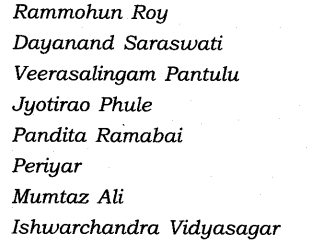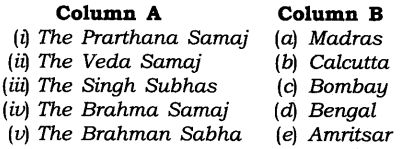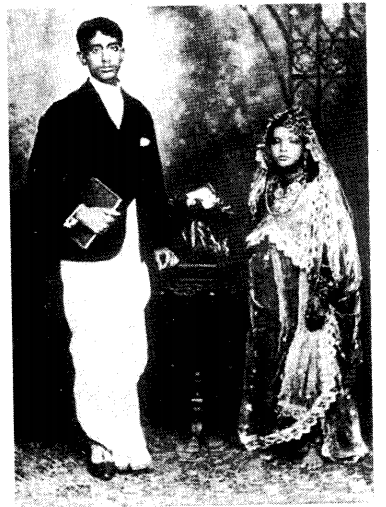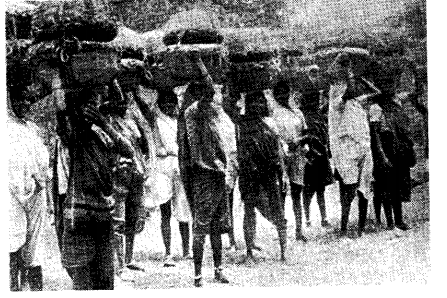NCERT Solutions for Class 8 Social Science History Chapter 9 Women, Caste and Reform
Question 1.
What social ideas did the following people support:
Answer:
These people supported the following ideas:
- Spread of education among women.
- Widow remarriage.
- Caste equality and justice.
- Abolition of child marriage.
- Social equality for untouchables.
Question 2.
State whether true or false:
- When the British captured Bengal they framed many new laws to regulate the rules regarding marriage, adoption, the inheritance of property, etc.
- Social reformers had to discard the ancient texts in order to argue for reform in social practices.
- Reformers got full support from all sections of the people of the country.
- The Child Marriage Restraint Act was passed in 1929.
Answer:
- True
- False
- False
- True
Question 3.
How did the knowledge of ancient texts help the reformers promote new laws?
Answer:
The reformers tried to convince people that widow burning, caste distinctions, child marriage, etc had no sanction in ancient texts. Their knowledge of ancient texts gave them immense confidence and moral support which they utilised in promoting new laws. They did not get feared when people raised voice against the reforms they had brought.
Question 4.
What were the different reasons people had for not sending girls to school?
Answer:
Vidyasagar in Calcutta (now Kolkata) and many other reformers in Bombay. (now Mumbai) set up schools for girls.
- When the first schools were opened in the mid-nineteenth century, many people were afraid of them.
- They feared that schools would take girls away from home.
- They would prevent them from doing their domestic duties.
- Girls had to travel through public places in order to reach school. This would have a corrupting influence on them.
- GMs should stay away from public spaces.
Question 5.
Why were Christian missionaries attacked by many people in the country? Would some people have supported them too? If so, for what reasons?
Answer:
Christian Missionaries were attacked in the country by many people because they suspected that they were involved in forced conversion and conversion using money power of poor and tribal people from Hinduism to Christianity. If some people supported them, that was because they felt this might improve the economical condition and education of the poor and tribals.
Question 6.
In the British period, what new opportunities opened up for people who came from castes that were regarded as “low”?
Answer:
With the expansion of cities, new demands of labor created. Drains had to be dug, roads laid, buildings constructed and cities cleaned. This required coolies, diggers, carriers, bricklayers, sweepers, rickshaw pullers, etc. This labour came from people who belonged to the “low” caste. They left their villages and small towns and shifted to the cities to get work. Some went to work in plantations in Assam, Mauritius, Trinidad, and Indonesia. Although it was not easy to work in the new locations, poor people saw this an opportunity to get away from the exploitations of the upper-caste.
Question 7.
How did Jyotirao, the reformer, justify their criticism of caste inequality in society?
Answer:
Jyotirao Phule, born in 1827, was the most vocal amongst the “Low-caste” leaders.
- He attacked the Brahmans’ claim of their superiority to others. He argued the Aryans were foreigners, who came from outside the subcontinent.
- They defeated and subjugated the true children of the country and looked at the defeated population as inferior.
- According to Phule, the “upper” castes had no right to their land and power. In reality, the land belonged to the so-called low castes.
- Phule opined that there existed a golden age when warrior-peasants tilled the land and ruled the Maratha countryside in just and fairways.
- He proposed that the Shudras (labouring castes) and Ati Shudras (untouchables) should unite to challenge caste discrimination.
- The Satyashodhak Samaj association founded by Phule propagated caste equality.
Question 8.
Why did Phule dedicate his book Gulamgiri to the American movement to free slaves?
Answer:
Jyotirao Phule wrote a book in 1873. He named the book Gulamgiri meaning slavery. Some ten years before this, the American Civil War had been fought, leading to the end of slavery in America. Phule dedicated his book to all those Americans who had fought to free slaves. He did this in order to establish a link between the conditions of the lower castes in India and the black slaves in America.
Question 9.
What did Ambedkar want to achieve through the temple entry movement?
Answer:
Ambedkar was born into a Mahar family. In childhood, he experienced various forms of caste prejudices in his everyday life.
- Ambedkar led three such movements for temple entry between 1927 and 1935.
- His aim was to make everyone see the power of caste prejudices within society.
Question 10.
Why were Jyotirao Phule and Ramaswami Naicker critical of the national movement? Did their criticism help the national struggle in any way?
Answer:
- Both Jyoti Rao Phule and Naicker were critical of national movement in their own times.
- Jyoti Rao Phule was critical of nationalism preached by upper castes. He wrote that they give advice to Shudra, Muslim and Parsi youth to forget their differences and come together for progress of nation, later it will be “Me here and you over there” all over again.
- E V Ramaswamy Naicker became member of Congress. But left it in disgust when he found out that at a feast, organised by nationalists, seating arrangement was based on caste distinctions.
- Their assertions, forceful speeches and writings did lead to rethink and self-criticism among the upper caste nationalist leaders.
Class 8 History Chapter 9 Women, Caste, and Reform Exercise Questions
Question 1.
Choose the correct option.
(i) The Brahmo Samaj was founded by
(a) Dayanand Saraswati
(b) Raja Rammohun Roy
(c) Vivekananda
(d) Ishwar Chandra Vidyasagar
(ii) The practice of Sati was banned in the year
(a) 1800
(b) 1821
(c) 1827
(d) 1829
(iii) A widow home was established at Poona by
(a) Tarabai Shinde
(b) Pandita Ramabai
(c) Mumtaz Ali
(d) Rokeya Sakhawat Hossain
(iv) Peasants and artisans were referred to as
(a) Vaishyas
(b) Shudras
(c) Untouchables
(d) Kshatriyas
(v) Periyar founded
(a) Self Respect Movement
(b) Temple Entry Movement
(c) Paramhans Mandali
(d) Dalit Movement
(vi) The Mohammedan Anglo-Oriental College was opened by
(a) Khizr Khan
(b) Maulana Abul Kalam Azad
(c) Sayyid Ahmed Khan
(d) Khan Abdul Gaffar Khan
Answer:
(i) (b), (ii) (d), (iii) (b), (iv) (b), (v) (a), (vi) (c).
Question 2.
Fill in the blanks with appropriate words to complete each sentence.
- According to the Child Marriage Restraint of ……….. and woman below the age of ………….. could marry.
- …………. were an important Act no man below the age untouchable caste of present-day Andhra Pradesh.
- Tarabai Shinde Published a book named …………..
- Raja Rammohun Roy was well versed in …………, …………… and several other Indian and European languages.
- The Satnami movement was founded by ……………. who belonged to a low caste family.
- In 1873, Jyotirao Phule wrote a Book Gulamgiri meaning …………………..
- The Begums of………….. played a vital role in promoting education among women.
Answer:
- 18, 16
- Madigas
- Stripurushtulna
- Sanskrit, Persian
- Ghasidas
- Slavery
- Bhopal
Question 3.
State whether each of the following statements is True or False.
- Raja Rammohun Roy founded the Arya Samaj in 1875.
- Pandita Ramabai was a great scholar of Sanskrit and she founded a widow’s home at Poona to provide shelter to widows.
- The Begums of Bhopal started schools for Muslim girls in Patna.
- Ishwar Chandra Vidyasagar strongly criticized widow remarriage.
- The Arya Samaj was an association that attempted to reform Hinduism.
- Dr. B.R. Ambedkar and E. V. Ramaswamy Naicker continued the movement for caste reform in the 20th century.
- Dr. Bhimrao Ambedkar is popularly known as Periyar.
Answer:
- False
- True
- False
- False
- True
- True
- False
Question 4.
Match the items given in Column A correctly with those given in Column B.
Answer:
(i) (c), (ii) (a), (iii) (e),(iv) (b), (v) (d)
Class 8 History Chapter 9 Women, Caste, and Reform Very Short Answer Type Questions
Question 1.
Why are social reformers described so?
Answer:
Social reformers are described so because they felt that some changes were essential in society and unjust practices needed to be rooted out.
Question 2.
How did reformers bring changes in society?
Answer:
They brought changes in society by persuading people to give up old practices and adopt a new way of life. .
Question 3.
What do you mean by ‘sad’?
Answer:
Widows who chose death by burning themselves on the funeral pyre of their husbands were known as ‘sati’, meaning virtuous woman.
Question 4.
Who was known as Vaishyas?
Answer:
Traders and moneylenders were known as Vaishyas.
Question 5.
Who was Raja Rammohun Roy?
Answer:
Raja Rammohun Roy was a learned social reformer. He was well versed in Sanskrit, Persian, and several other Indian and European languages. He raised voice against the practice of Sati and got it rooted out.
Question 6.
What was the hook swinging festival?
Answer:
It was a popular festival in which devotees underwent a peculiar form of suffering as part of ritual worship. With hooks pierced through their skin, they swung themselves on a wheel.
Question 7.
Who was Mumtaz Ali?
Answer:
Mumtaz Ali was a social reformer who reinterpreted verses from the Koran to argue for the education of women.
Question 8.
Who published the book named Stripurushtulna? What is it about?
Answer:
Tarabai Shinde published Stripuru-shtulna. It is about the social differences between men and women.
Question 9.
How did the widow’s home at Poona help the widows?
Answer:
It trained them so that they could manage financial support for themselves.
Question 10.
What was the contribution of Christian missionaries in spreading education among tribal groups and lower castes?
Answer:
These missionaries set up schools for tribal groups and lower caste children. Here, they were equipped with some skills to make their way into a new world.
Question 11.
Why do people view leather workers with contempt?
Answer:
Leatherworkers work with dead animals which are seen as dirty and polluting. Hence, people see them with contempt.
Question 12.
Who was Madigas?
Answer:
They were experts at cleaning hides, tanning them for use, and sewing sandals.
Question 13.
Who were Shudras?
Answer:
They belonged to laboring castes.
Question 14.
Who was Ati Shudras?
Answer:
They were untouchables.
Question 15.
What was the Satyashodhak Samaj? Who founded it?
Answer:
The Satyashodhak Samaj was an association that propagated caste equality. It was founded by Jyotirao Phule.
Question 16.
Why did E.V. Ramaswamy Naicker leave the Congress?
Answer:
He left the congress because he found nationalists adhering to caste distinctions. At a feast organised by them, the lower castes were made to sit at a distance from the upper castes.
Question 17.
Name the Hindu scriptures which were criticized by Periyar.
Answer:
The codes of Manu, the ancient lawgiver and the Bh^gavad Gita and the Ramayana.
Question 18.
Why were untouchable students not allowed to enter the classrooms where upper-caste boys were taught?
Answer:
There was a false notion among the upper-caste that untouchables would pollute the rooms where their children were taught.
Class 8 History Chapter 9 Women, Caste, and Reform Short Answer Type Questions
Question 1.
What did Raja Rammohun Roy do to end the practice of sati?
Answer:
Raja Rammohun Roy was a great social reformer. He moved to see the tyranny of old practices that were deeply rooted in Indian society. Burning of widows on the funeral pyre of their husbands was one such old practice which, Rammohun Roy felt, needed to be rooted out immediately. He began a campaign against this.
As he had a deep knowledge of Sanskrit, Persian, and several other Indian and European languages, die tried to show through his writings that the practice of sati had no sanction in ancient texts. He got support from the British officials who had also begun to criticise Indian traditions and customs by the early 19th century. Finally, in 1829, the practice of Sati was banned.
Question 2.
Give an account of the movement that spread in different parts of the country in favour of widow remarriage. Did the movement get success?
Answer:
The movement in favour of widow remarriage spread in different parts of the country by the second half of the 19th century. Veerasalingam Pantulu formed an association for widow remarriage in the Telugu- speaking areas of the Madras Presidency. Around the same time young intellectuals and reformers in Bombay pledged themselves to work for the same cause.
In the north the founder of the Arya Samaj Swami Dayanand Saraswati also supported widow remarriage. However, the movement did not get much success. The number of widows who actually remarried remained low. Those who remarried were not easily accepted in the society. The conservative people never approved the new law.
Question 3.
What do you know about Tarabai Shinde and Pandita Ramabai? What did they do for improving the condition of women?
Answer:
Tarabai Shindewas a woman who got an education at home at Poona. She is better known for publishing a book named Stripurushtulna meaning a comparison between women and men. She, in this book, criticises the social differences between men and women. Pandita Ramabai was a great scholar of Sanskrit.
She found Hinduism very oppressive towards women and wrote a book about the pathetic condition of Hindu women belonging to the upper caste. She started a widow’s home at Poona to provide shelter to widows who had been maltreated by their husband’s relatives. Here women were given the training to make them self-dependent.
Question 4.
Give a brief description of movements that were organised by people from within the lower castes against caste discrimination.
Answer:
By the second half of the 19th century, people from within the lower castes began to raise voice against caste discrimination. They organised movements against this practice and demanded social equality and justice. The Satnami movement became famous in Central India. It was initiated by Ghasidas, who came from a low caste, worked among the leather workers, and organised a movement to improve their social status. In Eastern Bengal, Haridas Thakur’s Matua sect worked among low caste Chandala cultivators. Haridas questioned Brahmanical texts that supported caste discrimination. Shri Narayana Guru belonged to Ezhavas, a low caste in present-day Kerala. He proclaimed the ideals unity of all people within one sect, a single caste and one god. By organising these movements the leaders coming from low-caste tried to create awareness amongst the lower castes.
Question 5.
Who was E.V. Ramaswamy Naicker? What, did he do to improve the condition of the untouchables?
Answer:
E.V. Ramaswamy Naicker belonged to a middle-class family. He had been an ascetic in his early life and had studied Sanskrit scriptures carefully. Afterward, he became a member of Congress but quit it when he found that at a feast organised by nationalists, seating arrangements followed caste discrimination, i.e. the lower castes were made to sit at a distance from the upper-castes. He founded the Self Respect Movement which inspired untouchables to fight for their dignity. He argued that untouchables were the true upholders of an original Tamil and Dravidian culture which had been subjugated by Brahmans. He felt that all religious authorities saw social divisions and inequality as God-given. Untouchables had to free themselves from all religions to achieve equal social status.
Class 8 History Chapter 9 Women, Caste, and Reform Long Answer Type Questions
Question 1.
Why were changes necessary in Indian society?
Answer:
Indian society had been a prey to many evil practices for a long time. Men and women were treated differently. Women were subjected to many restrictions. They were not allowed to go to schools. They were not allowed to choose their husbands. Child-marriage was an established custom in the society. Most children were married off at an early age. Both Hindu and Muslim men could many more than one wife. In some parts of the country, sati was in practice. Those widows were praised who chose death by burning themselves on the funeral pyre of their husbands. Women’s rights to property were also restricted.
One more evil practice that had crippled Indian society was that all people did not enjoy equal status. The upper-caste consisted of Brahmans and Kshatriyas, availed all privileges. But other than these people were subjected to exploitation. The untouchables, who did menial works, were considered polluting. They were not allowed to enter temples, draw water from the well used by the upper castes. They were seen as inferior human beings.
These evil customs and practices had eclipsed the progress of society. Hence, debates and discussions began to take place from the early 19th century, with the development of new forms of communications. For the first time, books, newspapers, magazines, leaflets and pamphlets were printed. They spread awareness among the common mass.
Social reformers like Raja Rammohun Roy, Ishwarchander Vidyasagar, came forward and took initiatives to bring changes in society by abolishing the evil practices one after Another.
Question 2.
How did women involve themselves in their upliftment?
Answer:
By the end of the 19th century, Indian women themselves began to work for their upliftment. They began to get higher education in universities. Some of them trained to be doctors, some became teachers. Many women began to write and publish their critical views on the status of women in society. The name of Tarabai Shinde is worth mentioning here. She got an education at home at Poona. She published a book, Stripurushtulna, meaning a comparison between men and women. She criticised the social differences between men and women. Another woman, Pandita Ramabai, was a great scholar of Sanskrit.
She criticised Hinduism which was so oppressive towards women. She wrote a book about the miserable lives of upper-caste Hindu women. She established a widow home at Poona to provide shelter to widows who had been ill-treated in their families. From the early 20 th century, Muslim women such the Begums of Bhopal and Begum Rokeya Sakhawat Hossain played an active role in spreading education among Muslim girls. They founded schools for them. Begum Rokeya Sakhawat Hossairi fearlessly criticised the conservative ideas. She argued that religious leaders of every faith accorded an inferior position to women.
The orthodox Hindus and Muslims got alarmed to see all this. Several Hindu nationalists felt that Hindu women were adopting Western ways which would corrupt Hindu culture and erode family values. Orthodox Muslims were equally worried about the impact of these changes. Unaware of all these, women, from the early 20th century, began to form political associations, pressure groups to push through laws for female suffrage and better health care and education for them. Some of them even joined various kinds of nationalist and socialist movements from the 1920s.
Class 8 History Chapter 9 Women, Caste, and Reform Source-Based Questions
Question 1.
Read the following extract (Sources 1 and 4) taken from the NCERT textbook and answer the questions that follow:
“We first tie them down to the pile”
Rammohun Roy published many pamphlets to spread his ideas. Some of these were written as a dialogue between the advocate and critic of a traditional practice. Here is one such dialogue on sati:
An advocate of Sati:
Women are by nature of inferior understanding, without resolution, unworthy of trust … Many of them, on the death of their husbands, become desirous of accompanying them; but to remove every chance of their trying to escape from the blazing fire, in burning them we first tie them down to the pile.
Opponent of Sati:
When did you ever afford them a fair opportunity of exhibiting their natural capacity? How then can you accuse them of want of understanding? If, after instruction in knowledge and wisdom, a person cannot comprehend or retain what has been taught him, we may consider him as deficient; but if you do not educate women how can you see them as inferior.
Questions:
(a) What notions did the society have in favour of the practice of sati?
(b) What arguments did the reformers put against the practice of sati?
Answers:
(a) The society believed women to be of inferior understanding without resolution and unworthy of trust. So, she was not allowed to live without her husband. Therefore, she was forced to be inflamed with the body of her husband after his death.
(b) The reformers accused the society of not recognising women’s potentialities. They said that the society had never bothered to educate women and had always neglected them. So, it was quite unjustified to call them inferior and untrustworthy.
Question 2.
“We are also human beings”
In 1927, Ambedkar said:
We now want to go to the Tank only to prove that like others, we are also human beings … Hindu society should be reorganised on two main principles – equality and absence of casteism.
Questions:
(a) Who was Ambedkar?
(b) On what basis did he wish Hindu society to be reorganised?
Answers:
(a) Ambedkar was a Dalit leader. He belonged to a Mahar family. He did a lot for the upliftment of the condition of Dalits.
(b) He wished Hindu society to be reorganised on the basis of two principles – equality and absence of casteism.
Class 8 History Chapter 9 Women, Caste, and Reform Picture-Based Questions
Question 1.
Observe the pictures below taken from is NCERT textbook and answer the questions that follow:
Questions:
(i) This is a picture of a child bride at the beginning of the 20th century. Which Act was passed to prevent child marriage and when?
(ii) What did the Act mention?
Answers:
(i) In 1929, the Child Marriage Restraint Act was passed to prevent this practice.
(ii) According to the Act no man below the age of 18 and a woman below the age of 16 could marry.
Question 2.
Questions:
(i) Who are these people? What are they doing in the picture?
(ii) What did they do for upper-caste landowners?
Answers:
(i) These people are Dublas of Gujarat. In the picture, they are carrying mangoes to the market.
(ii) Dublas did hard work for upper-caste landowners. They cultivated their lands and worked at a variety of odd jobs at the landowner’s house.